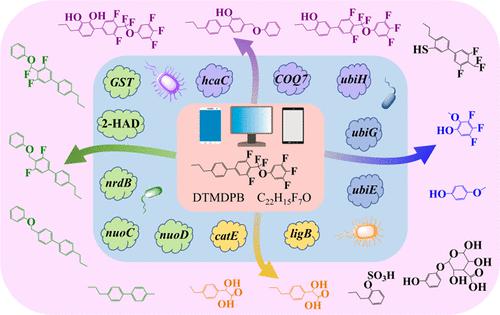当前位置:
X-MOL 学术
›
Environ. Sci. Technol.
›
论文详情
Our official English website, www.x-mol.net, welcomes your
feedback! (Note: you will need to create a separate account there.)
Aerobic Microbial Transformation of Fluorinated Liquid Crystal Monomer: New Pathways and Mechanism
Environmental Science & Technology ( IF 10.8 ) Pub Date : 2023-12-15 , DOI: 10.1021/acs.est.3c04256 Xifen Zhu 1 , Yuanyuan Yu 1 , Weikun Meng 2 , Jiahui Huang 1 , Guanyong Su 2 , Yin Zhong 3 , Xiaolong Yu 1 , Jianteng Sun 1 , Ling Jin 4 , Ping'an Peng 3 , Lizhong Zhu 5
Environmental Science & Technology ( IF 10.8 ) Pub Date : 2023-12-15 , DOI: 10.1021/acs.est.3c04256 Xifen Zhu 1 , Yuanyuan Yu 1 , Weikun Meng 2 , Jiahui Huang 1 , Guanyong Su 2 , Yin Zhong 3 , Xiaolong Yu 1 , Jianteng Sun 1 , Ling Jin 4 , Ping'an Peng 3 , Lizhong Zhu 5
Affiliation

|
Fluorinated liquid crystal monomers (FLCMs) have been suggested as emerging contaminants, raising global concern due to their frequent occurrence, potential toxic effects, and endurance capacity in the environment. However, the environmental fate of the FLCMs remains unknown. To fill this knowledge gap, we investigated the aerobic microbial transformation mechanisms of an important FLCM, 4-[difluoro(3,4,5-trifluorophenoxy)methyl]-3, 5-difluoro-4′-propylbiphenyl (DTMDPB), using an enrichment culture termed as BG1. Our findings revealed that 67.5 ± 2.1% of the initially added DTMDPB was transformed in 10 days under optimal conditions. A total of 14 microbial transformation products obtained due to a series of reactions (e.g., reductive defluorination, ether bond cleavage, demethylation, oxidative hydroxylation and aromatic ring opening, sulfonation, glucuronidation, O-methylation, and thiolation) were identified. Consortium BG1 harbored essential genes that could transform DTMDPB, such as dehalogenation-related genes [e.g., glutathione S-transferase gene (GST), 2-haloacid dehalogenase gene (2-HAD), nrdB, nuoC, and nuoD]; hydroxylating-related genes hcaC, ubiH, and COQ7; aromatic ring opening-related genes ligB and catE; and methyltransferase genes ubiE and ubiG. Two DTMDPB-degrading strains were isolated, which are affiliated with the genus Sphingopyxis and Agromyces. This study provides a novel insight into the microbial transformation of FLCMs. The findings of this study have important implications for the development of bioremediation strategies aimed at addressing sites contaminated with FLCMs.
中文翻译:

含氟液晶单体的好氧微生物转化:新途径和机制
氟化液晶单体(FLCM)被认为是新兴污染物,因其频繁出现、潜在毒性作用和在环境中的耐受能力而引起全球关注。然而,FLCM 的环境命运仍然未知。为了填补这一知识空白,我们使用富集培养物称为 BG1。我们的研究结果表明,在最佳条件下,最初添加的 DTMDPB 的 67.5 ± 2.1% 在 10 天内发生了转化。通过一系列反应(例如还原脱氟、醚键断裂、脱甲基化、氧化羟基化和芳环开环、磺化、葡萄糖醛酸化、 O-甲基化和硫醇化)总共鉴定出14种微生物转化产物。 BG1联盟包含可以转化DTMDB的必需基因,例如脱卤相关基因[例如谷胱甘肽S-转移酶基因( GST )、2-卤酸脱卤酶基因(2-HAD)、 nrdB 、 nuoC和nuoD ];羟基化相关基因hcaC 、 ubiH和COQ7 ;芳环开环相关基因ligB和catE ;和甲基转移酶基因ubiE和ubiG 。分离出两株 DTMDPB 降解菌株,分别隶属于鞘氨醇菌属(Sphingopyxis ) 和农杆菌属 (Agromyces) 。这项研究为 FLCM 的微生物转化提供了新的见解。 这项研究的结果对于制定旨在解决 FLCM 污染场地的生物修复策略具有重要意义。
更新日期:2023-12-15
中文翻译:

含氟液晶单体的好氧微生物转化:新途径和机制
氟化液晶单体(FLCM)被认为是新兴污染物,因其频繁出现、潜在毒性作用和在环境中的耐受能力而引起全球关注。然而,FLCM 的环境命运仍然未知。为了填补这一知识空白,我们使用富集培养物称为 BG1。我们的研究结果表明,在最佳条件下,最初添加的 DTMDPB 的 67.5 ± 2.1% 在 10 天内发生了转化。通过一系列反应(例如还原脱氟、醚键断裂、脱甲基化、氧化羟基化和芳环开环、磺化、葡萄糖醛酸化、 O-甲基化和硫醇化)总共鉴定出14种微生物转化产物。 BG1联盟包含可以转化DTMDB的必需基因,例如脱卤相关基因[例如谷胱甘肽S-转移酶基因( GST )、2-卤酸脱卤酶基因(2-HAD)、 nrdB 、 nuoC和nuoD ];羟基化相关基因hcaC 、 ubiH和COQ7 ;芳环开环相关基因ligB和catE ;和甲基转移酶基因ubiE和ubiG 。分离出两株 DTMDPB 降解菌株,分别隶属于鞘氨醇菌属(Sphingopyxis ) 和农杆菌属 (Agromyces) 。这项研究为 FLCM 的微生物转化提供了新的见解。 这项研究的结果对于制定旨在解决 FLCM 污染场地的生物修复策略具有重要意义。































 京公网安备 11010802027423号
京公网安备 11010802027423号